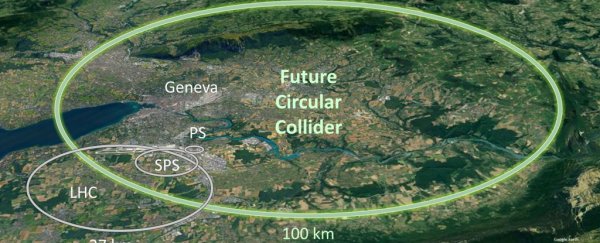Some of the Universe's deepest secrets are locked up so tight, a whole new kind of subatomic cataclysm is needed to tear them free.
To unleash those kinds of forces, European physicists want to build a particle accelerator to rival anything we've seen, one that will make the famous 27 kilometre (16.7 mile) Large Hadron Collider (LHC) look like a high school science experiment.
Officials at the European Organization for Nuclear Research (CERN) have just presented the results of a study that informs the design and construction of technology expected to open the next chapter on particle physics.
Their plan begins with a 100 kilometre (62 mile) circular collider, costing in the ballpark of €9 billion (US$10 billion).
For the time being it's quite simply referred to as the Future Circular Collider, or FCC. Once it actually starts hunting for new physics sometime in the next few decades, it might have a different name.
But either way, this next generation accelerator should help us crack matter like never before.
CERN's current king of colliders, the LHC, is one of a complex of particle accelerators on the Swiss-French border near Geneva.
Its loop of superconducting magnets nudges opposing streams of protons towards 0.999999990 light speed, supplying each with 6.5 teraelectronvolts of energy – enough to condense a variety of particles out of the carnage of their impacts.
The most famous of these was the Higgs boson, a particle first predicted in the 1960s as responsible for missing mass, and finally experimentally confirmed in 2012.
Its discovery completed the set of predicted objects that make up the fundamental building blocks of reality, a theory we call the Standard Model.
But even with the model confirmed, our search for understanding is far from over. There are plenty of big questions we have yet to get a grip on, and current technology just isn't up to the challenge of providing the evidence we need to answer them.
Why is gravity so weak, compared to the other forces? Where does the neutrino's tiny mass come from? Why is the Higgs boson so incredibly light? Where is all the Universe's antimatter? And what is the true nature of this thing we call dark matter?
Forget the combined 13 TeV impacts inside the LHC. It's hoped the FCC's ring of doom will eventually manage an insane 100 TeV for smashing protons.
For the first stage, though, CERN is planning something less ambitious - a machine that collides electrons with their antimatter counterpart, positrons.
This is different from what the LHC can achieve by smashing together hadrons, which have more mass than electrons; hadron composition - three quarks held together by gluons - also leaves more of a mess to sort out after the collision.
Funny enough, the energies used in the first stage of FCC won't even be as high as those in the LHC, but they'll still be higher than anything achieved previously for these kinds of particles. Plenty enough to give birth to Higgs bosons, and the end result will be much easier to analyse.
Eventually adding a fully fledged 100 kilometre proton accelerator will, however, require another €15 billion of investment, so we can't hope it will be open for business any sooner than at least the middle of the century.
Meanwhile, China has plans of its own. Its 30 billion yuan (US$4.3 billion) Circular Electron–Positron Collider (CEPC) could be in operation as soon as the 2030s, getting a head start the multiple collisions needed to amass the enormous bank of statistics necessary for finding flaws in the Standard Model.
Japan might also get their own version of a Higgs-generating accelerator, if the government can be convinced it's worth the investment.
There's no guarantee that the FCC will see the light of day, either. Higgs particle aside, the LHC just hasn't lived up to expectations, failing to provide signs of a slew of new particles as physicists had hoped.
Convincing stakeholders to back this horse is going to be tougher than ever, but we can't wait for them to get started.
